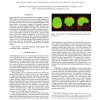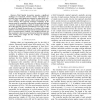611 search results - page 101 / 123 » Using GP to Model Contextual Human Behavior |
IJVR
2007
13 years 7 months ago
2007
—In this paper we report about the use of computer generated affect to control body and mind of cognitively modeled virtual characters. We use the computational model of affect A...
ISBI
2011
IEEE
12 years 11 months ago
2011
IEEE
Segmenting brain from non-brain tissue within magnetic resonance (MR) images of the human head, also known as skull-stripping, is a critical processing step in the analysis of neu...
IROS
2009
IEEE
14 years 2 months ago
2009
IEEE
— Fluid bipedal locomotion remains a significant challenge for humanoid robotics. Recent bio-inspired approaches have made significant progress by using small numbers of tightl...
ISWC
2003
IEEE
14 years 1 months ago
2003
IEEE
Context-aware computing describes the situation where a wearable / mobile computer is aware of its user’s state and surroundings and modifies its behavior based on this informat...
GEM
2008
13 years 9 months ago
2008
Classifying the endgame positions in Chess can be challenging for humans and is known to be a difficult task in machine learning. An evolutionary algorithm would seem to be the ide...


